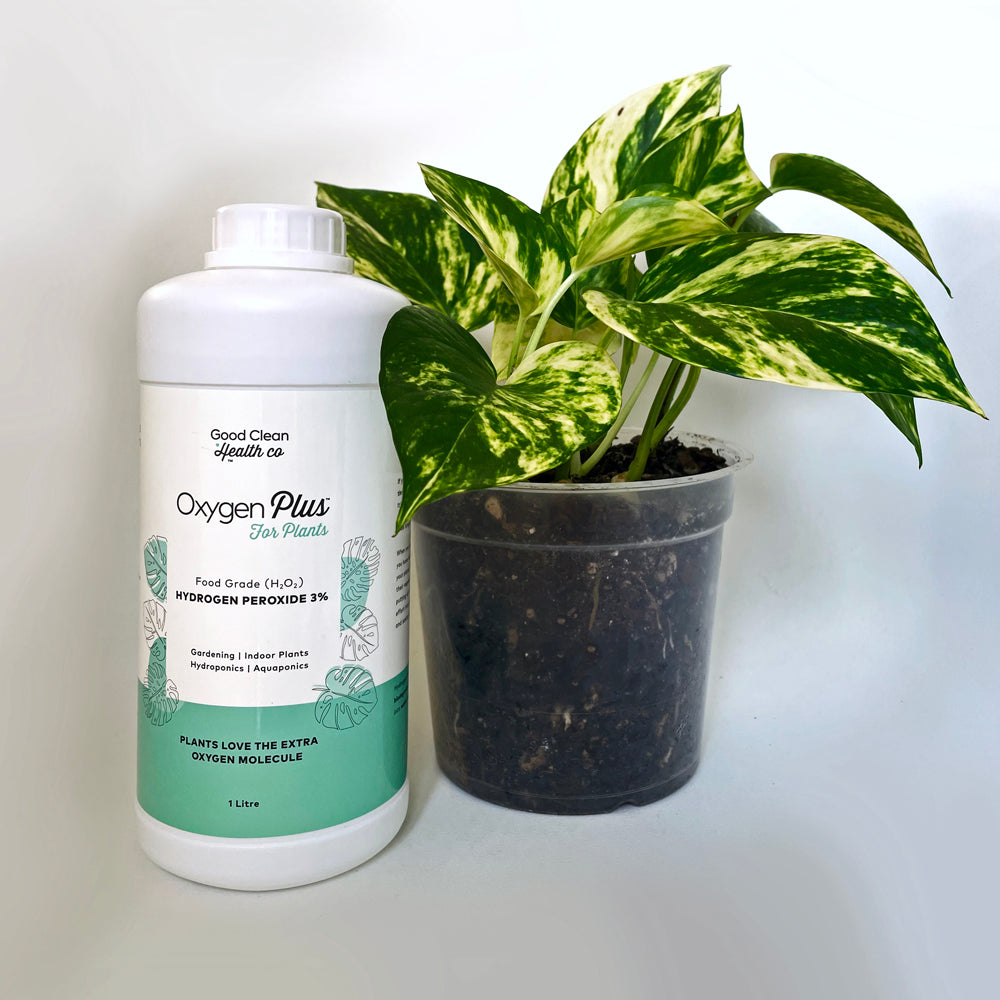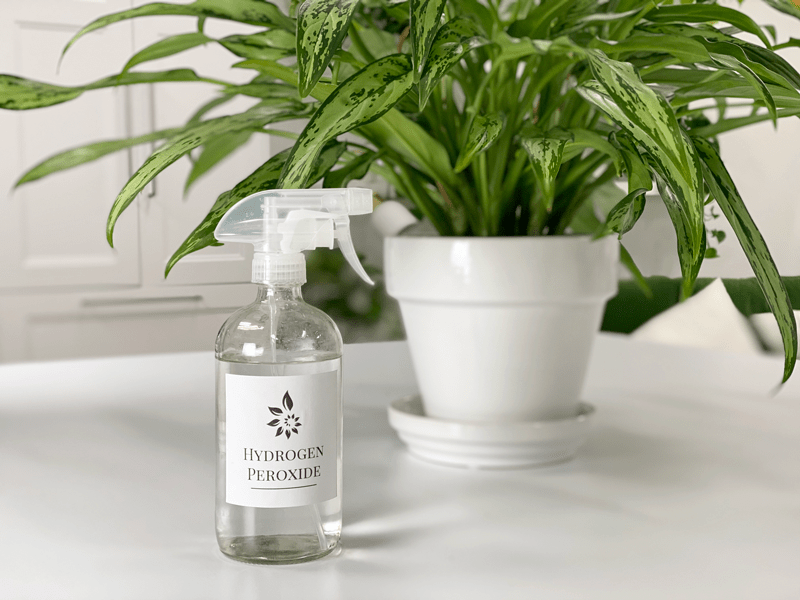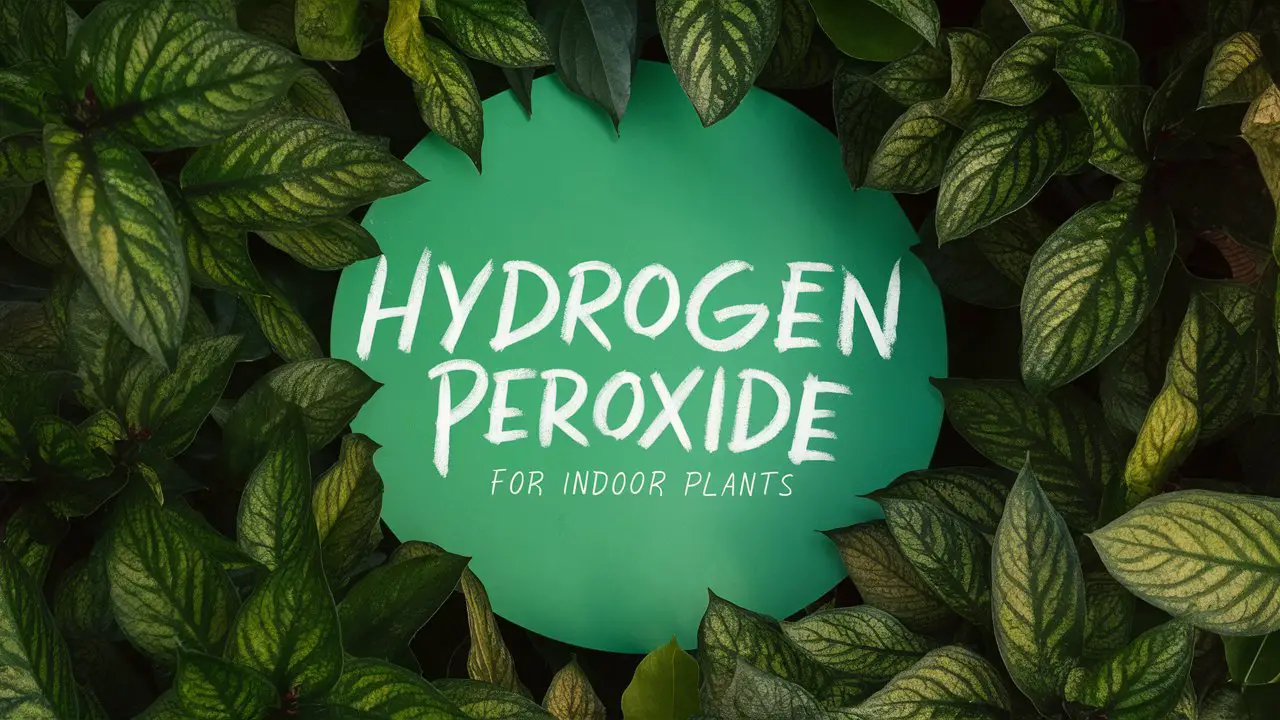Mix one part hydrogen peroxide with four parts water. Use this solution to water your indoor plants once a week.
Hydrogen peroxide can enhance the health of your indoor plants. It helps eliminate pests and prevents root rot. This simple solution releases extra oxygen into the soil, promoting root growth and overall plant vitality. The antifungal properties of hydrogen peroxide also protect your plants from infections.
Using it weekly ensures a balanced and healthy environment for your plants. This method is safe, effective, and easy to incorporate into your plant care routine. Start using hydrogen peroxide today for greener, healthier indoor plants. Remember to store the mixture in a cool, dark place to maintain its effectiveness.
The Power Of Hydrogen Peroxide
Hydrogen peroxide is a secret weapon for healthy indoor plants. This simple compound can work wonders, fostering growth and vitality. Let’s explore the power of hydrogen peroxide and how it benefits your indoor garden.
A Natural Ally For Plant Growth
Hydrogen peroxide acts as a natural ally for plant growth. It helps in several ways:
- Root Health: It prevents root rot and fungal infections.
- Oxygen Supply: It releases extra oxygen to the roots.
- Pest Control: It keeps pests at bay.
Using hydrogen peroxide ensures your plants stay strong and vibrant.
The Science Behind Oxygenation
Hydrogen peroxide’s chemical formula is H2O2. It breaks down into water and oxygen. This extra oxygen benefits plant roots:
| Benefit | Description |
|---|---|
| Enhanced Root Growth | Oxygen promotes healthy root development. |
| Improved Nutrient Absorption | Roots absorb nutrients more efficiently with extra oxygen. |
Hydrogen peroxide ensures roots get the oxygen they need.
Here’s how to use hydrogen peroxide for your plants:
- Mix one part hydrogen peroxide with ten parts water.
- Water your plants with the mixture once a week.
- Observe your plants for signs of improvement.
This simple routine can make a big difference.
Choosing The Right Concentration
Using hydrogen peroxide for indoor plants can be very beneficial. It helps with root rot, mold, and pests. But, choosing the right concentration is key. Using the wrong strength can harm your plants. This section will guide you through the right concentration.
Common Concentrations Available
Hydrogen peroxide comes in different concentrations. The most common are:
- 3% solution: This is the most common and safe for plants.
- 6% solution: This is stronger and used for tougher problems.
- 12% solution: This is very strong and used rarely.
Dilution Best Practices
It’s important to dilute hydrogen peroxide correctly. Here are some best practices:
- For a 3% solution: Mix one part hydrogen peroxide with two parts water.
- For a 6% solution: Mix one part hydrogen peroxide with four parts water.
- For a 12% solution: Mix one part hydrogen peroxide with ten parts water.
Always use fresh, clean water for dilution. Use a spray bottle for easy application. Make sure to label your mixture to avoid confusion.
| Concentration | Hydrogen Peroxide | Water |
|---|---|---|
| 3% | 1 part | 2 parts |
| 6% | 1 part | 4 parts |
| 12% | 1 part | 10 parts |
By following these guidelines, you can ensure your plants get the right care. Proper concentration and dilution are crucial for plant health. Happy gardening!
Preparation Steps
Hydrogen peroxide can help indoor plants thrive. The preparation steps are crucial for success. Follow these steps carefully to ensure your plants benefit.
Mixing Solutions
Creating the right hydrogen peroxide solution is essential. Here’s how:
- Use a 3% hydrogen peroxide solution.
- Mix one part hydrogen peroxide with two parts water.
- Stir the mixture gently to combine.
Safety Measures
Safety should always be a priority. Follow these guidelines:
- Wear gloves to protect your skin.
- Avoid contact with eyes.
- Keep the solution away from children and pets.
By following these steps, you prepare a safe and effective solution. Your indoor plants will thank you!

Credit: www.lovethatleaf.co.nz
Watering With Hydrogen Peroxide
Hydrogen peroxide is a fantastic tool for indoor plant care. It helps plants grow strong and healthy. It also fights off harmful bacteria and fungi. Let’s explore how to use hydrogen peroxide effectively for watering your plants.
Frequency And Amounts
Knowing how much and how often to water is crucial. Use a 3% hydrogen peroxide solution. Mix one part hydrogen peroxide with three parts water.
- Small plants: Use 1 cup of the mix per plant.
- Medium plants: Use 2 cups of the mix per plant.
- Large plants: Use 3 cups of the mix per plant.
Water your plants with this mix every two weeks. This keeps your plants free from diseases and pests.
Signs Of Adequate Watering
Look for these signs to know if your plants are happy:
- Healthy leaves: Leaves are green and firm.
- Strong stems: Stems are upright and sturdy.
- New growth: Your plant is growing new leaves and stems.
If you see yellow leaves or wilting, adjust your watering schedule. Too much or too little water can harm your plants. Keep an eye on them to ensure they thrive.
| Plant Size | Water Amount | Frequency |
|---|---|---|
| Small | 1 cup | Every 2 weeks |
| Medium | 2 cups | Every 2 weeks |
| Large | 3 cups | Every 2 weeks |
Combatting Root Rot
Root rot is a common problem for indoor plants. It occurs when roots sit in water too long. This can kill your plants. Hydrogen peroxide can help save your plants from root rot.
Identifying Symptoms
To treat root rot, you must first spot it. Here are some symptoms:
- Yellowing leaves
- Wilting despite moist soil
- Mushy or dark roots
- Foul smell from the soil
Check your plant’s roots often. This helps catch root rot early.
Treatment Protocol
Using hydrogen peroxide can save your plant. Follow these steps:
- Remove the plant from the pot.
- Rinse the roots gently with water.
- Trim off any mushy or dark roots using clean scissors.
- Prepare a hydrogen peroxide solution:
- Mix 1 part hydrogen peroxide with 2 parts water.
- Soak the roots in the solution for 5 minutes.
- Repot the plant in fresh, well-draining soil.
- Water the plant lightly with the same peroxide solution.
Hydrogen peroxide kills root rot fungi. It also gives oxygen to the roots.
| Step | Description |
|---|---|
| 1 | Remove the plant from the pot |
| 2 | Rinse roots gently with water |
| 3 | Trim off mushy or dark roots |
| 4 | Mix 1 part hydrogen peroxide with 2 parts water |
| 5 | Soak roots for 5 minutes |
| 6 | Repot in fresh, well-draining soil |
| 7 | Water lightly with peroxide solution |
Regular checks and good watering habits prevent root rot. Happy growing!
Boosting Seed Germination
Hydrogen peroxide can work wonders for your indoor plants. It helps in boosting seed germination effectively. Using hydrogen peroxide ensures healthier and stronger seedlings. This method is simple and quite effective for all types of seeds.
Pre-sowing Treatment
Pre-sowing treatment involves soaking seeds in hydrogen peroxide solution. This treatment helps in breaking down the seed coat. It also kills any harmful pathogens present on the seeds.
To prepare the solution, mix one part hydrogen peroxide with ten parts water. Soak the seeds in this solution for 30 minutes. After soaking, rinse the seeds with clean water. This process enhances seed germination rate.
Monitoring Germination Progress
Monitoring germination progress is crucial for healthy seedlings. After pre-sowing treatment, plant the seeds as usual. Keep an eye on the moisture level of the soil. Ensure the soil stays moist but not waterlogged.
Check the seeds daily for signs of germination. Note the time it takes for the seeds to sprout. This helps in understanding the effectiveness of the hydrogen peroxide treatment.
You can create a simple table to monitor the progress:
| Date | Seed Type | Germination Status |
|---|---|---|
| MM/DD/YYYY | Tomato | Sprouting |
| MM/DD/YYYY | Peppers | No Sprout |
Keeping track helps in fine-tuning your future treatments. It also ensures your indoor garden thrives.
Fungal Infection Prevention
Fungal infections can cause severe damage to indoor plants. Using hydrogen peroxide can help prevent these infections. It is a simple and effective method. Let’s explore how you can use it to keep your plants healthy.
Common Indoor Plant Fungi
Indoor plants are prone to several types of fungi. These include:
- Powdery Mildew: Looks like white dust on leaves.
- Root Rot: Causes roots to turn brown and mushy.
- Leaf Spot: Creates brown or black spots on leaves.
Recognizing these fungi is the first step in prevention. Knowing what to look for helps you act quickly.
Preventative Spraying Techniques
Preventing fungal infections can be done through regular spraying. Here is a simple guide:
- Mix one part hydrogen peroxide with ten parts water.
- Pour the mixture into a spray bottle.
- Spray the solution on the leaves and soil.
- Do this once a week for best results.
Hydrogen peroxide helps kill fungal spores. It also promotes healthy root growth. Regular spraying keeps your plants fungus-free.
Here is a quick reference table:
| Fungi Type | Symptoms | Prevention |
|---|---|---|
| Powdery Mildew | White dust on leaves | Weekly spraying |
| Root Rot | Brown, mushy roots | Healthy soil |
| Leaf Spot | Brown or black spots | Clean leaves |
Using hydrogen peroxide is safe and effective. Your plants will thank you for the care.

Credit: nouveauraw.com
Pest Control Strategies
Hydrogen peroxide is a valuable tool for controlling pests on indoor plants. This natural solution helps keep your plants healthy and pest-free. Let’s explore how hydrogen peroxide can help with pest control.
Types Of Pests Affected
Hydrogen peroxide can combat various pests that harm indoor plants. These include:
- Aphids: Tiny insects that suck sap from plants, causing damage.
- Fungus Gnats: Small flies that breed in moist soil.
- Spider Mites: Tiny arachnids that can cause leaf damage.
- Whiteflies: Small, white insects that feed on plant sap.
Application Tips For Pest Management
Using hydrogen peroxide for pest control is easy. Follow these simple steps:
- Mix Solution: Combine one part hydrogen peroxide with four parts water.
- Spray Plants: Pour the solution into a spray bottle. Spray the plants, focusing on affected areas.
- Soil Treatment: Pour the solution directly into the soil. This helps kill larvae and eggs.
- Repeat as Needed: Apply every few days until pests are gone.
Always test a small area of the plant first. This ensures it does not harm the plant.
Benefits Of Hydrogen Peroxide For Pest Control
| Benefit | Description |
|---|---|
| Natural Solution | Safe for plants and non-toxic. |
| Effective | Kills pests and their eggs. |
| Easy to Use | Simple to mix and apply. |
Using hydrogen peroxide for pest control is effective and safe. Keep your indoor plants healthy and thriving with this natural solution.
Enhancing Nutrient Uptake
Indoor plants need essential nutrients to grow healthy and strong. Hydrogen peroxide can help your plants absorb these nutrients better. This simple solution can make a big difference in plant growth.
The Role Of Oxygen
Oxygen is crucial for plant roots. It helps them breathe and take in nutrients. Hydrogen peroxide releases extra oxygen into the soil. This boost helps the roots grow stronger and healthier.
With more oxygen, roots can absorb nutrients more effectively. This means your plants will grow faster and look greener.
Optimizing Soil Conditions
Good soil is key for plant health. It should have the right balance of air, water, and nutrients. Hydrogen peroxide can improve these conditions.
Here is a simple table to show how hydrogen peroxide helps:
| Hydrogen Peroxide Effect | Benefit to Soil |
|---|---|
| Increases oxygen levels | Boosts root health |
| Fights harmful bacteria | Reduces root rot |
| Improves water drainage | Prevents overwatering |
To use hydrogen peroxide, follow these steps:
- Mix one part 3% hydrogen peroxide with two parts water.
- Pour the solution into the soil around your plants.
- Repeat once a week for best results.
This routine will help keep your indoor plants healthy. Hydrogen peroxide is a simple way to enhance nutrient uptake and optimize soil conditions.
Safety And Storage
Hydrogen peroxide is useful for indoor plants. It helps to treat plant diseases and pests. But, safety and storage are important. This ensures your plants and home stay safe.
Handling With Care
Always handle hydrogen peroxide with care. Wear gloves to protect your skin. Avoid contact with your eyes. Store it away from children and pets. Do not mix it with other chemicals. Use it in a well-ventilated area.
Proper Storage Guidelines
Proper storage of hydrogen peroxide is crucial. Keep it in a cool, dark place. Use the original container for storage. Make sure the cap is tightly closed. Check the expiration date before use. Discard expired hydrogen peroxide safely.
| Storage Tips | Details |
|---|---|
| Location | Cool, dark place |
| Container | Original container |
| Cap | Tightly closed |
| Expiration | Check before use |
Following these guidelines ensures the safe use of hydrogen peroxide. Your indoor plants will benefit greatly.
Troubleshooting Common Issues
Using hydrogen peroxide for indoor plants is beneficial. But, improper use can cause problems. This section helps troubleshoot common issues. Identify symptoms and address plant stress effectively.
Overuse Symptoms
Overusing hydrogen peroxide can harm plants. Look for these symptoms:
- Yellowing leaves
- Wilting
- Brown leaf tips
- Stunted growth
If you see these signs, reduce hydrogen peroxide use. Check plant health regularly.
Addressing Plant Stress
Plants show stress from too much hydrogen peroxide. Follow these steps to help:
- Stop using hydrogen peroxide for a week.
- Water plants thoroughly to flush out excess.
- Trim damaged leaves and stems.
- Monitor plant recovery closely.
If stress symptoms persist, consider repotting the plant. Use fresh soil and ensure proper drainage.
Hydrogen peroxide can help indoor plants. Use it wisely and watch for these common issues.

Credit: www.feathersinthewoods.com
Real-life Success Stories
Seeing is believing. Many plant lovers have used hydrogen peroxide with great results. Here are some real-life success stories. These examples show how effective this simple treatment can be.
Testimonials From Plant Enthusiasts
Jane D.: “My spider plant was dying. I used a hydrogen peroxide mix. Within a week, it was healthy again. The leaves were greener and stronger.”
Tom K.: “My indoor garden struggled with root rot. Hydrogen peroxide saved my plants. I mixed one part peroxide with two parts water. The results were amazing.”
Emily R.: “My succulents had mold. I sprayed them with hydrogen peroxide. The mold disappeared quickly, and my plants thrived.”
Before And After Comparisons
| Plant | Before | After |
|---|---|---|
| Spider Plant | Wilted, yellow leaves | Healthy, green leaves |
| Indoor Garden | Root rot, dying plants | Strong roots, vibrant plants |
| Succulents | Moldy, weak | Mold-free, thriving |
These stories show the power of hydrogen peroxide for plant care. Many have seen their plants transform. It’s an easy and effective solution.
Frequently Asked Questions
How Do You Use Hydrogen Peroxide On Potted Plants?
Mix 1 part hydrogen peroxide with 3 parts water. Water the plants with this solution. It helps oxygenate the soil. Use once a week for best results.
How To Get Rid Of Bugs On Indoor Plants With Hydrogen Peroxide?
Mix one part hydrogen peroxide with four parts water. Spray this solution on the affected plants. Repeat weekly to eliminate bugs.
How To Revive A Dying Plant With Hydrogen Peroxide?
Mix one part hydrogen peroxide with three parts water. Water the plant with this solution. This helps oxygenate roots and kill pests. Ensure the soil is well-drained. Repeat once a week until the plant revives.
What Is The Ratio Of Hydrogen Peroxide To Water For Gnats In Indoor Plants?
Use a 1:4 ratio of hydrogen peroxide to water. Mix 1 part hydrogen peroxide with 4 parts water.
Conclusion
Using hydrogen peroxide for indoor plants is simple and effective. It promotes healthy growth and prevents diseases. Always dilute it properly to avoid damage. Regular use can improve soil aeration and root health. Incorporate it into your plant care routine for vibrant, thriving plants.
Enjoy a greener, healthier indoor garden.

My mission is to help you bring the beauty of nature indoors with expert advice, detailed plant care guides, and creative design ideas.




